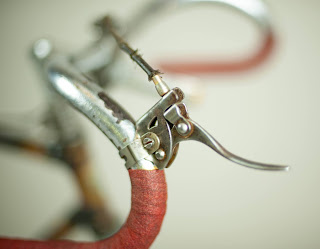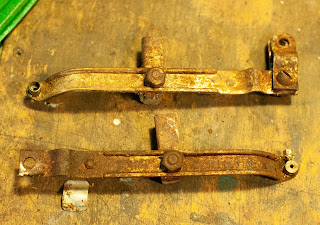Firstly let me just say that the following posts on"The Art of the Sympathetic Restoration" are only my personal thoughts on, and a signal in the direction I will be taking going forward within the world of Vintage/Classic racing bicycle collecting, buying, selling and restoration etc...of course many others will have a completely different approach, and that is a good thing, different strokes for different folks I always say.
Over the past several years it has been been becoming more and more obvious to me that my approach to tbicycle restoration has been quite a bit too hard edged...I guess if I am honest about it, my first thoughts upon receiving an old racing bike, that has no known history or provenance, has been 'strip it and repaint it' it, and if no decals of suitable quality are available (which is about half the time) recreate my own.
I am realizing now that actually each bike really needs to be far more carefully thought about and assessed before taking that radical and irreversible step of stripping it down to bare metal.
Some questions that I am asking myself now (and have been for a while) are...is it in original paint? how much of that originality is left, how much can can be saved if needed?, how rare is this particular bike in it's current condition? etc etc. Now don't get me wrong, I absolutely love restoring racing bikes, I really enjoy the challenge of recreating a vintage racing bike for myself and customers that should look and ride/feel almost exactly like it would have done when new...but going forward I am removing the knee jerk reaction of doing that to most bikes that cross my path.
So as my first example for "The Art of the Sympathetic Restoration" I am undertaking what I consider to be an easy choice for this undertaking...a pretty original 1920's NZ built race bike.
A few months ago I happened upon this rather neglected looking bike on a local sales site, it was located down at the other end of the country (of course!), but I was keen on the Major Taylor cockpit and especially on the narrow racing/sports 28" spear point mudguards, the bike had obviously been pressed into service as a commuter at the end of it's racing career.
When my friend, Jason (Bidrider Motorcycle Delivery Company, I highly recommend his service if you are in NZ) who picks up my South Island bikes for me, delivered it...still dragging some weeds wound through it's spokes, he was slightly amused at my purchase...though this is far from the first rusty heap he has dragged into my shop!
It was instantly clear that hiding under a heavy patina was the original paint, I had half suspected this from the very unclear photos in the original ad, but was pleasantly surprised non the less.
But what was really exciting was that the original decal "Ruby" with a flying wheel on each end, could just be made out on the down tube.
If you have had anything to do with pre-war New Zealand racing bikes you will know that at least 70% + of them have been repainted at some point, and almost never with the original decals or anything to give you a clue as to it's origins. Now I know that some collectors out there claim to be able to identify some makers, I am personally a little more circumspect about identifying pre war frames.
Having the name still on the bike instantly gave this bike a provenance that meant I could justify to myself the many many hours of work that would be needed to restore this machine.
A little gold with red stripping peeping through just below the seat cluster...
The Major Taylor stem and classic 20's-30's bars that first caught my eye...love that imposing Miller headlight on the the end of the outrigger, I will restore the lights and guards at some later point and refit them to the bike, but for this project I am returning the bike back into into it's original racing trim.
I was pleased to find the narrow racing rims, even though covered in a thick coat of surface rust, were free of actual rust holes, the brass spoke nipples, now oxidized green should come up nicely with a time of work/time, the galvanized spokes seems to be hanging in there as well.
Overall the bike looked to be in pretty original order, right down to the twin fixed wheel drive train, and had clearly been left untouched for decades...and lots of them!
Phillips saddle at first looked pretty knackered, but like the rest of the bike, responded well to a bit of careful TLC.



























































































